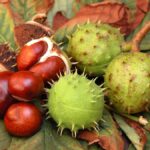Daikon is a long white radish sweet-mild to peppery in flavor and juicy crisp.
Daikon–which means “long root” in Japanese–is most commonly eaten raw or stir-fried. It is a staple in nearly all meals in Japan, Korea, and China.
Daikon is often shredded and served as an accompaniment to Japanese raw fish dishes, such as sashimi. It can be sliced, cubed or julienne and served as a side vegetable and as a garnish.
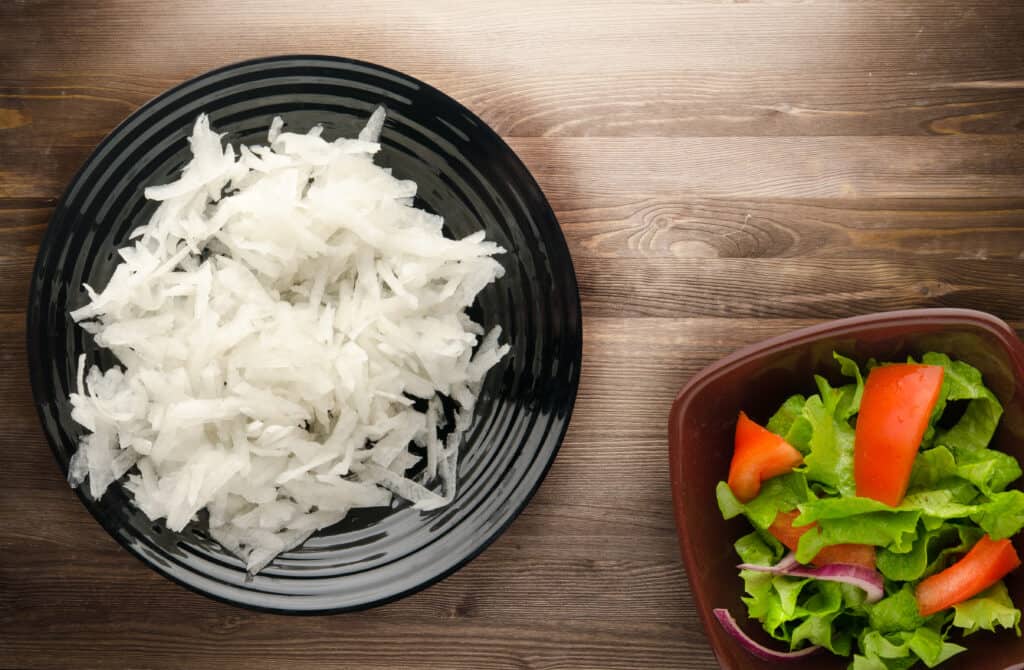
Daikon also can be added to stews, meatballs, and meatloaf, and it can be puréed with other vegetables and served as a light soup.
Daikons come to harvest in the spring and fall. Spring daikons will taste more peppery than fall and winter daikons. Daikons harvested in summer can be pungent.
See also Tasty Ways to Serve Radishes
How to choo se daikon
se daikon
- Select daikon that is firm, not wrinkled, and slightly shiny with no spots or bruises.
- Very large daikons are likely to be fibrous with a spongy texture.
How to store daikon
- Daikons are not keepers and should be used quickly or they will lose moisture and become flabby and dry out.
- Store daikon in a perforated plastic bag in the refrigerator. Daikons will remain crisp for up to a week.
How to prepare daikon
- Scrub and peel daikon before using it.
- Grate, cube, or julienne strips.
- Daikon can be puréed after cooking.
- Do not overcook daikon as it will lose flavor.
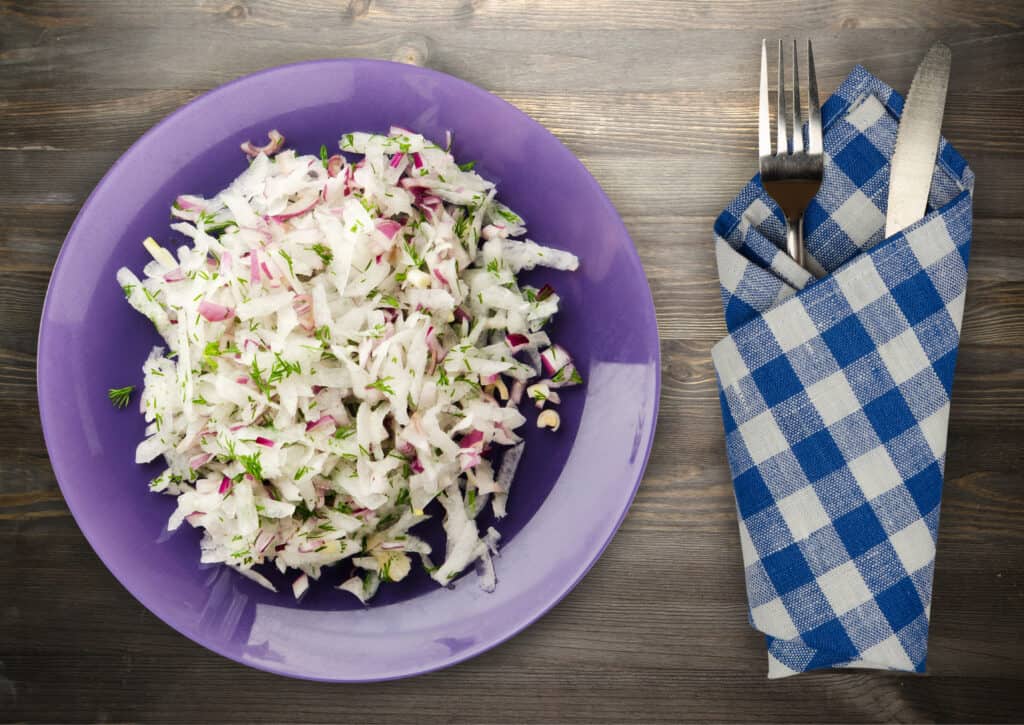
Daikon serving suggestions
- Daikon can be served raw or cooked.
- Serve slivered, diced, sliced, and added to relishes, salads, or crudités.
- Serve thinly sliced with carrots and sesame.
- Grate and serve with raw fish dishes such as sashimi—mix with lemon juice and vinegar.
- Grate and sprinkle with vinaigrette or with vinegar or lemon juice.
- Cook like a turnip and serve.
- Cook briefly with other root vegetables such as potatoes, then purée for light-bodied soup.
- Grate or slice and add to stews and stir-fries.
- Cut into large slices or strips and braise with other vegetables to serve a mixed vegetable dish.
- Sprinkle with salt to reduce the peppery tang.
Daikon flavor partners
- Daikon pairs well with other vegetables, seafood or fish, poultry, pork, lamb, and beef.
Daikon nutrition
- Daikon is low in calories 10 per ½ cup and contains a small amount of vitamin C.
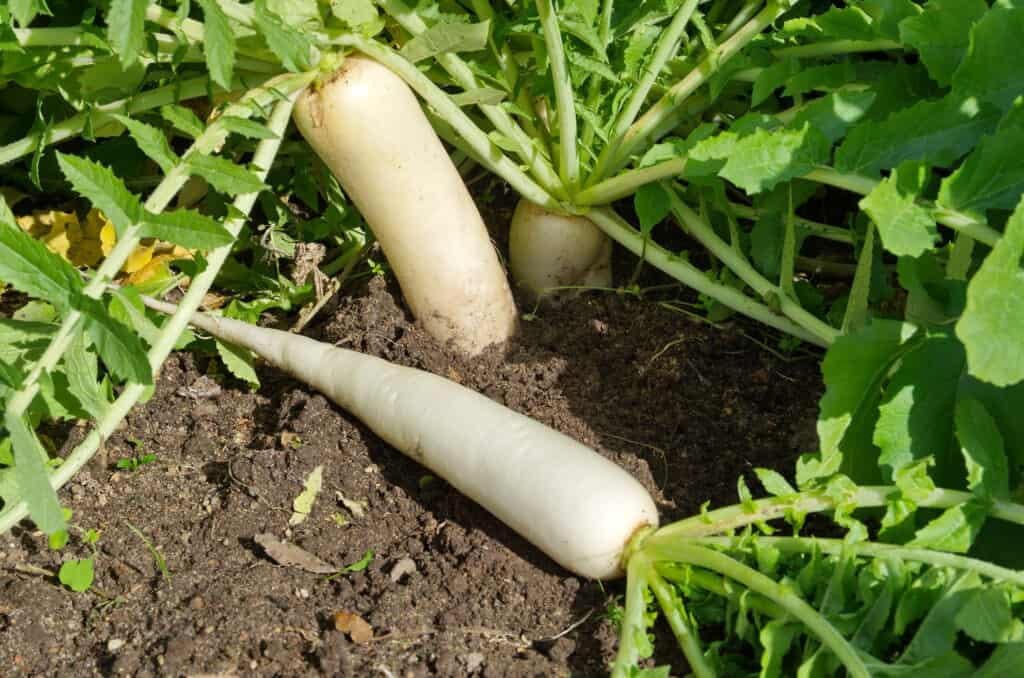
About daikon
- The daikon is radish.
- Daikons can be harvested as small as 5 inches (12 cm) in length. The smaller the daikon the milder and less peppery it will taste and the less fibrous its texture.
- Daikon is also called long white radish, oriental radish, Japanese radish, Chinese radish, and loh baak or lo pak.
- There are several varieties of daikon. The most common is one that looks like an extra-large white carrot. This variety can grow to about a foot (30 cm) in length, is cylindrical to about 3 inches (7.5 cm) in diameter and is tapered at the tip like a carrot. Daikons can weigh from one-half to two pounds.
- Other daikon varieties are shorter and more round. They can be shades of rose, purple-black, or greenish in color. One variety known as “red winter radish” is a turnip-looking root, green with a pink tip, and another called a “green winter radish” looks something like a cucumber.
- Daikons originated in the eastern Mediterranean more than 4,000 years ago.
- The daikon migrated to China with traders around 500 B.C
- In Korea, daikons are made into pickles or kim chee. Kim chee—which can also be made from cabbage and turnips–is usually spicy-hot and served as a condiment.
The botanical name of the daikon is Raphanus sativus var. longipinnatus.
Also of interest:
Articles of interest:
Best Herbs for Container Growing
Garden Planning Books at Amazon:
- Vegetable Garden Almanac & Planner
- Kitchen Garden Grower’s Guide Vegetable Encyclopedia
- Vegetable Garden Grower’s Guide
- Tomato Grower’s Answer Book
More kitchen tips:
Bring your harvest to the table. Kitchen prep tips and easy recipes for the vegetables you grow. Click below for vegetable prep and recipes you can use now.
- Almonds
- Apples
- Apricot
- Aprium
- Artichoke
- Arugula
- Asparagus
- Avocado
- Bamboo Shoots
- Banana
- Basil
- Beans, Dried
- Beans. Long
- Beans, Shell
- Beans, Snap
- Beets
- Bitter Melon
- Blackberry
- Bok Choy
- Broccoli
- Broccoli Raab
- Brussels Sprouts
- Cabbage
- Cardoon
- Carrots
- Cauliflower
- Celeriac
- Celery
- Chard
- Chayote Squash
- Cherimoya
- Cherries
- Chestnut
- Chickpea
- Chinese Cabbage
- Chives
- Cilantro
- Citron
- Clementine
- Collards
- Coriander
- Corn, Sweet
- Corn, Baby
- Corn Salad, Mache
- Cranberry
- Cress
- Cucumber
- Daikon
- Dandelion
- Dill
- Eggplant
- Endive, Belgian
- Endive and Escarole
- Fava Beans
- Fig
- Florence Fennel
- Garlic
- Ginger
- Grapefruit
- Grapes
- Guava
- Horseradish
- Jerusalem Artichoke
- Jicama
- Jujube
- Kale
- Kiwifruit
- Kohlrabi
- Kumquat
- Leeks
- Lemongrass
- Lemons
- Lettuce
- Lime
- Mache (Corn Salad)
- Mandarin Orange
- Mango
- Maple Syrup
- Marjoram
- Melons
- Michihili
- Mint
- Mizuna
- Mushrooms
- Mushrooms, Cremini
- Mustard Greens
- Napa Cabbage
- Nectarine
- Okra
- Olives
- Olive oil
- Onions
- Oranges
- Oregano
- Parsley
- Parsley Root
- Parsnips
- Passion Fruit
- Pawpaw
- Peaches
- Pears
- Peas, Garden Snap
- Peas, Snow
- Pei Tsai
- Peppers, Chili
- Peppers, Sweet
- Persimmon
- Pineapple
- Pineapple Guava
- Plantain
- Plums
- Pluots
- Pomegranate
- Potatoes
- Prickly Pear
- Pumpkin
- Quince
- Radicchio
- Radishes
- Raspberries
- Rosemary
- Rhubarb
- Rutabaga
- Sage
- Salsify
- Sauerkraut
- Savory
- Shallots
- Sorrel
- Spinach
- Squash, Summer
- Squash, Winter
- Strawberries
- Sunchokes
- Sunflower
- Sweet Potato
- Swiss Chard
- Tangerine
- Taro
- Tarragon
- Thyme
- Tomatillo
- Tomato
- Turnip
- Turnip Greens
- Yams


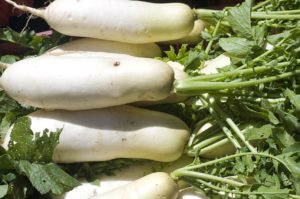 se daikon
se daikon











